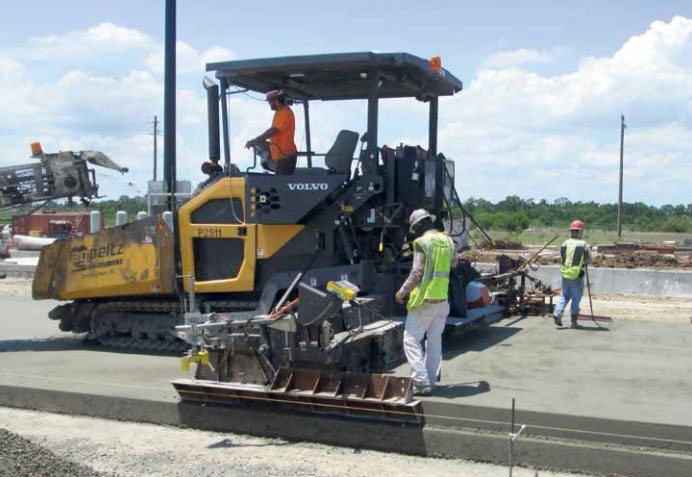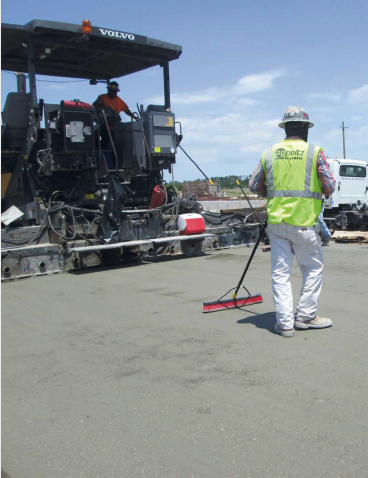Associated Construction Publications August 2016

By placing RCC, the Port estimated that it reduced the project construction schedule by four months while keeping maintenance to a minimum.
Cost-effective and durable, roller-compacted concrete (RCC) pavement is laying a solid foundation for a number of significant projects for the Port of Houston Authority (PHA). By 2020, the Port is expected to have 380 acres of mostly 18-inch-thick RCC, making it the largest RCC site in the U.S. For perspective, a similar amount of RCC would fill a 6-inch-thick single lane road stretching more than 800 miles across Texas from Orange to El Paso.
Since 2007, RCC has filled a key role in the Port Authority’s Bayport Container Terminal expansion – an integral part of the PHA’s capital improvement program that totals a proposed $314 million in 2016. High-performing, low-maintenance RCC pavements are strong and dense so they can handle the weight of heavy container-handling equipment such as gantry cranes that load containers on and off ships.
“The Port Authority has fully embraced RCC as cost-effective solution and the concrete pavement of choice at Bayport Terminal,” noted Matt Singel, Program Manager at the Cement Council of Texas and an authority on RCC. “Concrete and cement-stabilized pavement options including RCC are solving many of the difficult challenges – poor soils, high-water tables, heavy loading requirements and a need for fast construction – faced by the Port of Houston and other U.S. ports and intermodal facilities.”
The Port initially decided that RCC was a cost-effective option when the first phase of Bayport Terminal expansion was in its final design stage in 2007. The Port Authority encouraged RCC bid alternates for the two north container yard expansions. “The goal was to reduce cost and ensure long-term durability, and port leadership at that time believed RCC offered a sound solution,” said PHA Chief Construction Manager Brock Lewis.
Roller Compacted Concrete Reduces Construction Time
A complex of shipping and cargo-handling facilities, the port of Houston spans 25 miles along the Houston Ship Channel. In 2015, the Port ranked first in the U.S. in import tonnage and second in export tonnage. Once primarily a a bulk carrier facility, the Port Authority has significantly expanded its container-handling capacity over the past few years, in part to prepare for the 2016 completion of the Panama Canal expansion.
“The Port Authority believes this strategy will increase our business since the Panama Canal is doubling its capacity by increasing the number of cargo ships and the size of ships that pass through its waters, and the Port of Houston is closest port once ships leave the canal,” Lewis pointed out.
RCC is an economical, fast-construction candidate for many pavement applications. It has traditionally been used for pavements carrying heavy loads in lo-speed areas because of its relatively coarse surface. During the last 15 years, RCC has experienced dramatic improvements in mix design procedures, resulting in improved appearance and constructability. This has been one catalyst for its increased use in commercial areas and for local streets and highways.
“RCC production/placement rates are very high, making this an ideal concrete paving material for large, thick industrial pavements,” Singel noted. “Additionally, no formwork, finishing or steel (dowels or reinforcing) is needed, which further speeds placement and reduced labor costs.”
Other RCC Applications

RCC is an economical, fast-construction candidate for many pavement applications
Other popular RCC applications include industrial plant access roads and parking lots, truck/freight terminals, bulk commodity storage and distribution centers, military facilities, aircraft parking areas, roadways in public parks and temporary travel lanes that must be constructed quickly to divert traffic.
RCC was first used as a pavement option in the late 1970s and early 19080s at a canadian log sorting yard. In 1984, RCC came to Texas when Fort Hood military base in Killeen – the U.S. Army’s largest post – used the concrete to pave a tank storage stand.
“RCC’s major thrust has occurred over the past 15 years as more and more businesses and state, county and city governments have recognized it as a viable, long-term pavement,” Singel noted. “Its popularity will only continue.”
RCC gets its name from the heavy vibratory steel drum and rubber-tired rollers used to compact the concrete to its specified density before it begins to set up. This high density provides support while the cement is hydrating and building strength. RC has the same basic ingredients – well-graded aggregates (gravel and crushed stone), cementitious materials and water – of conventional concrete but also different mixture proportions.
What is the biggest difference in the two concretes? “RCC has a higher percentage of fine aggregates, which allows for tight packing and consolidation,” Singel said. “Due to the relatively lower water and cement contents of its mixtures, RCC pavements have reduced shrinkage compared to conventional concrete pavements.”
The cost of materials used in RCC is generally comparable to the cost of materials used in conventional concrete of similar strength. RCC typically has slightly lower cement content than conventional concrete, which can lead to savings in material costs.
Other current and future RCC projects at the PHA include Container Yard 6 of South Container Yard, West Container Yard, Barbours Cut Container Yard, and Phases 1, 2, and 7 of South Container Yard. Besides noting the positive RCC impact, Lewis said he generally has been pleased with the performance of the PHA’s capital improvements program.
“It’s a huge responsibility to get these major expansion projects such as the Bayport Container Yard Six North completed on time and on budget. As a city of Houston entity, we have to work through many challenges such as taking care of the environment, working with surrounding jurisdictions and meeting numerous business requirements. The enormous rainfall in the Houston area this past spring has also been a major issue for our construction schedule,” Lewis said.
“We are starting to see improvement in our overall performance, and we need to continue down that road with sound business strategies such as RCC utilization. Another challenge is to find numerous bidders on our projects even when the economy is on a downturn. It’s important to work with these larger construction companies to get their business, which means we need to do a better job of construction management.”
